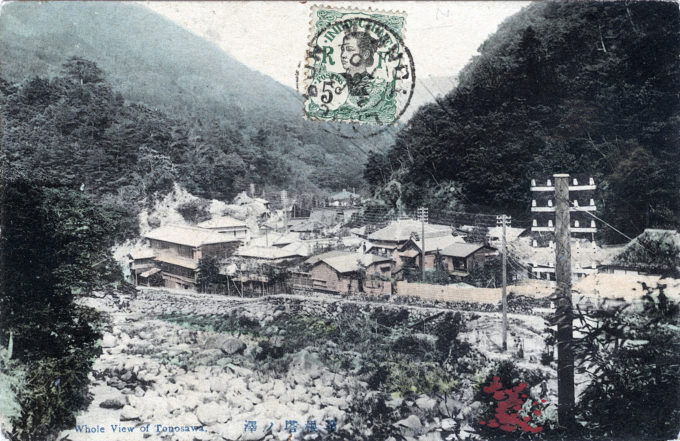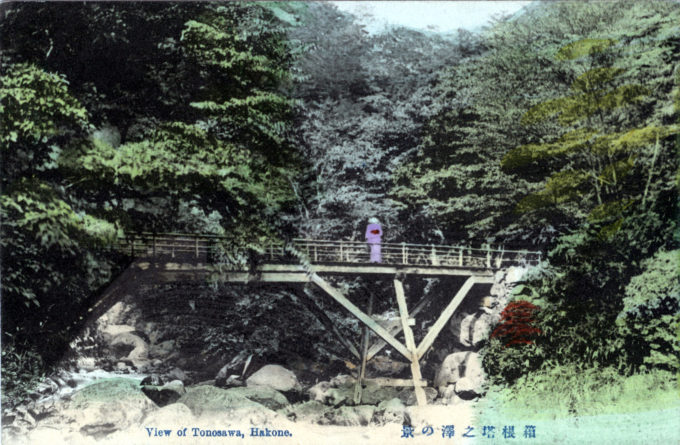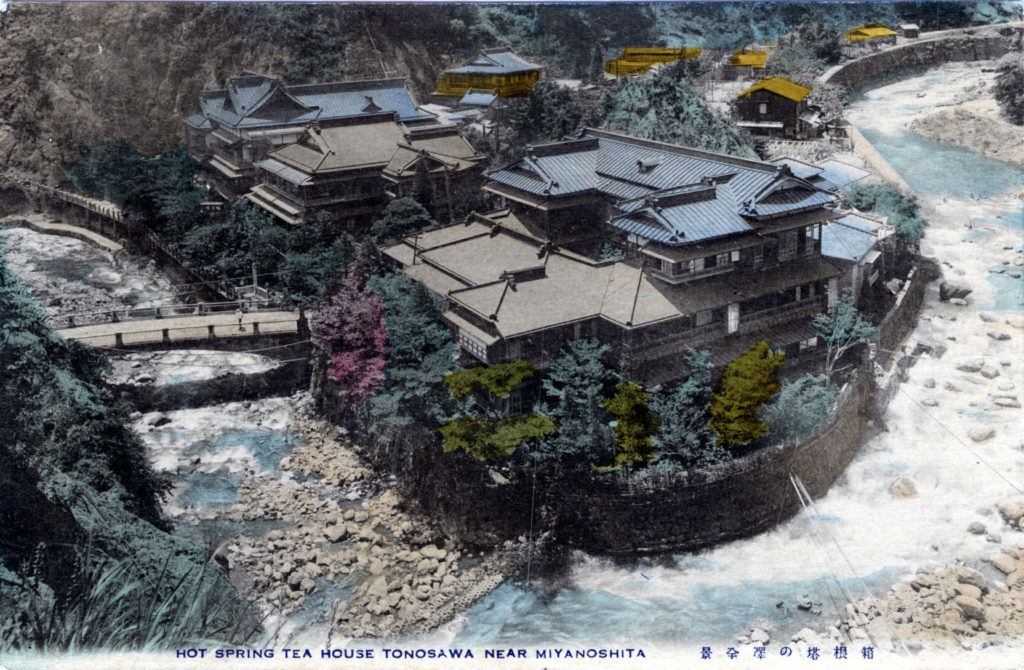
Hot Spring Tea House [at] Tonosawa, near Miyanoshita, c. 1920. Pictured are Ichinoyu Honkan (foreground), opened in 1630, and Kansuiro ryokan, opened in 1614. The latter was noted for several private baths of novel construction, some round and fan-shaped. The inns are seen here in the vicinity of the Chitose bridge, along the old imperial highway, the Tokaido, which separates the two onsen ryokan. (Nearby Hakone was the 10th post-station along the Tokaido.)
“Tonosawa is about 2 miles from Miyanoshita, along the new road, one side of which is very thickly over-shadowed with trees which grow on the surrounding mountain sides and on the other lies a valley.
“At the bottom of the valley a rapid torrent struggles among rocks and stones. On the way, is a charming little tea-house called Fujimi-tei, where a fine view of Mount Fuji and Miyanoshita meets the gaze looking up the valley – a spectacle on the same time charming and sublime.
“The finest view of Tonosawa is obtained from Tamano-o bridge, which crosses the Hayakawa.
“Yumoto is situated at the eastern end of the Hakone district and on the southern bank of the Hayakawa, so that it is the entrance to Hakone, being the nearest point to the Kozu station on the Tokaido Railway. A few cents will admit one to a beautiful garden with a cascade called Tama-dare-no-taki.”
– A Brief Sketch of Ashinoyu and Its Environs, compiled by M.K. Tamaki, published by the Matsuzaka Hotel, 1899
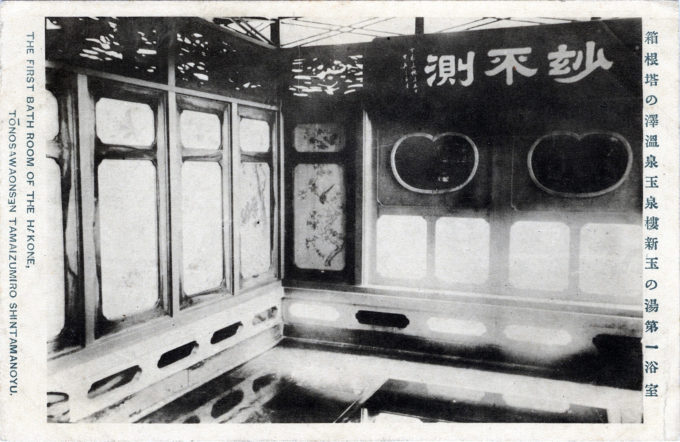
“The first bath of the Hakone [sic]”, Tonosawa-onsen, Hakone, c. 1910. Tonosawa hot spring was opened some 300 years ago, one of the seven great natural hot springs of Hakone. But, hot springs in the area are mentioned even earlier – in a thirteenth-century travelogue, Izayoi Nikki (‘Dairy of the Waning Moon’).
“Kansuiro Ryokan was formerly called ‘Motoyu Suzuki’. There was a man, named Hirobumi Ito, who visited Motoyu Suzuki frequently. He was one of the leaders of the shogunate at the end of the Edo era and later became the first prime minister of Japan. Mr. Ito visited and held parties here many times.
“One day he made a Chinese poem to be given to the owner, Zenzaemon Suzuki, as a largess. Mr. Ito picked out 3 characters from this poetry – 環 (kan, ring; rim), 翠 (sui, emerald; jade) and 楼 (ro, watchtower; lookout) – then, Japan’s first prime minister re-named the hotel as ‘Kansuiro’.”
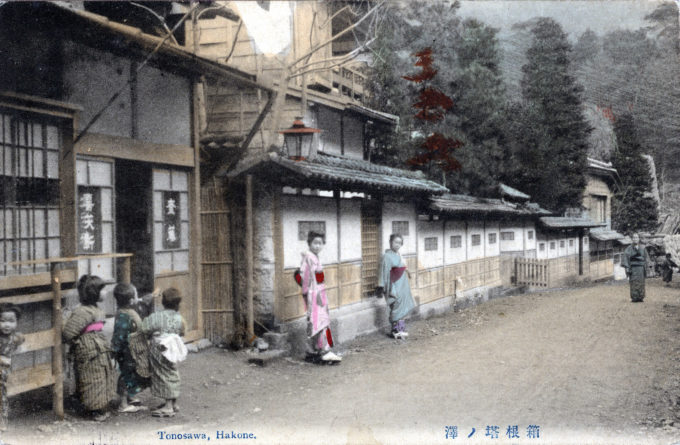
Tonosawa, Hakone, c. 1910. One of the more than fifty onsen [hot spring bathhouse] that stand in the village.
“Arrived at Yumoto, I was met by a swarm of coolies who bore down upon me with their rickishas, but, instead of pushing on the same day to Miyanoshita (as is generally done), I broke the journey at a little place about half-a-mile beyond Yumoto, called Tonosawa, and spent the night at an inn–Tamano-yu—which, although the European conveniences in it were few, was nevertheless delightful.
“Tonosawa lies near the mouth of a gorge, and is so shut in by hills that the sun does not shine upon it for more than two or three hours a day. In all my subsequent rambles through the country, I never came upon so pleasant a yadoya as the Tamano-yu. Speaking of it later on in the house of a missionary, two hundred miles away, I found my host equally enthusiastic about it, and there was another reason for regarding it with special attachment in his case, as it was there that he spent his honeymoon.
“I was welcomed with the usual chorus of ‘Ohayos,’ and had no sooner sat down near the entrance than one domestic relieved me of my bag and umbrella, two others attacked my boots, like so many terriers, and, as usual, had to give up the attempt to unlace them in despair, and a fourth conducted me in my slippers to my room, along the side of a picturesque court yard, over two or three rustic bridges spanning beautiful lakelets stocked with gold and silver fishes, through corridors glistening with polished pine and cherrywood, and, finally, up a spic-and span stairway of cedar into a spacious chamber, innocent of furniture save two chairs, but charming in its simplicity.
“In a few minutes the hibachi (fire-box) was brought in and set in the midst, with two instruments like knitting-needles with which to stir and trim the burning fuel, and the waiting-maid, Ewa, had some excellent tea, with rice and fish, set before me, and, in accordance with the custom of the country, faced me kneeling and demurely watched me during the whole time I was at my meal.
“… Being the only European in Tonosawa, I was regarded with a good deal of interest by the natives as I strolled about the village, and I had formed more than a nodding acquaintance with several of them when the time came for me to return. Though there is not much to see at Tonosawa itself, the picturesque situation of the little village, the kindliness of its people, the comforts of the accommodation at the Tamano-yu, and its very moderate rates, made my stay a very pleasant one.”
– Journeys Among the Gentle Japs in the Summer of 1895, by Rev. J.L.L. Thomas, Vicar of Aber-pkrgwm (Wales), 1897
- “Whole view of Tonosawa”, near Miyanosita, c. 1910.
- Tonosawa River, Hakone, c. 1910.


